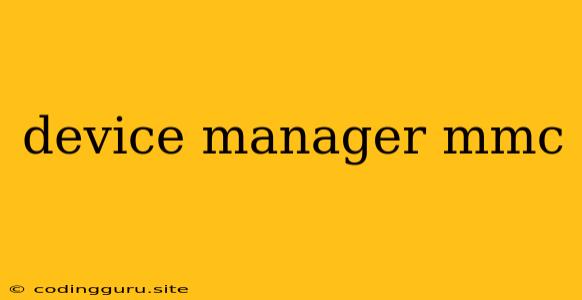What is Device Manager and How to Use It Effectively?
The Device Manager is a powerful tool in Windows operating systems that allows you to manage and troubleshoot the hardware connected to your computer. From simple peripherals like mice and keyboards to complex components like graphics cards and network adapters, Device Manager provides a centralized platform for viewing, configuring, and updating device drivers.
Understanding the MMC:
The Device Manager is a component of the Microsoft Management Console (MMC), a versatile framework for managing various aspects of your Windows system. This means that Device Manager itself isn't a standalone application but rather a part of the broader MMC structure.
Navigating the Device Manager:
-
Accessing the Device Manager: You can access Device Manager in several ways:
- Search: Type "Device Manager" in the Windows search bar.
- Control Panel: Navigate to Control Panel > System and Security > System, then click on "Device Manager" in the left pane.
- Run: Type "devmgmt.msc" in the Run dialog box (Windows key + R).
-
Device Hierarchy: Once you open Device Manager, you'll see a tree-like structure displaying various categories of hardware. This includes:
- Computer: Shows the root of the device tree.
- Disk drives: Lists all hard drives and other storage devices.
- Display adapters: Displays your graphics card(s).
- Human interface devices: Includes mice, keyboards, touchpads, and other input devices.
- Network adapters: Lists your network connections and adapters.
- Sound, video and game controllers: Lists audio and video devices.
-
Device Properties: Double-clicking on a device name opens its properties window. This window provides information about the device, including:
- General: Displays the device name, manufacturer, and current driver status.
- Driver: Allows you to update, roll back, disable, or uninstall drivers.
- Resources: Shows the device's assigned hardware resources, such as interrupt requests (IRQs) and memory addresses.
- Details: Provides detailed information about the device, including its hardware IDs and compatibility.
Troubleshooting with Device Manager:
Device Manager is essential for troubleshooting hardware issues:
- Device Errors: Look for devices with yellow exclamation marks or red crosses. These indicate problems with the device or its driver. Right-click on the device and choose "Properties" to troubleshoot.
- Updating Drivers: Outdated drivers can cause performance issues or incompatibility problems. Use the "Update Driver" option in the device properties to get the latest drivers.
- Disabling Devices: If a device is causing conflicts or problems, you can disable it temporarily by right-clicking and choosing "Disable". This will remove the device from active use.
- Uninstalling Drivers: If you're experiencing persistent issues, you can uninstall the driver. This will remove the driver files from your system. Remember to restart your computer after uninstalling a driver.
Using Device Manager for Other Purposes:
Device Manager isn't only for troubleshooting. It can be used for other purposes, such as:
- Hardware Identification: You can use Device Manager to identify the exact hardware components in your system, including their names and manufacturers.
- Driver Management: Device Manager helps you manage drivers, including updating, rolling back, and uninstalling them.
- Hardware Monitoring: While Device Manager doesn't provide real-time hardware monitoring, it can show you the current status of your devices and help you identify any issues.
Tips for Effective Device Manager Use:
- Regularly check for updates: Run a scan for hardware changes in Device Manager regularly to ensure your drivers are up-to-date.
- Understand device IDs: Device IDs are unique identifiers for each hardware component. They can be useful when searching for compatible drivers or troubleshooting specific hardware issues.
- Be cautious with driver updates: While updating drivers can improve performance, it can also lead to instability. Before updating drivers, it's recommended to create a system restore point.
- Consult manufacturer's website: For the latest drivers, it's often best to consult the manufacturer's website for your specific hardware components.
Conclusion:
Device Manager is an indispensable tool for any Windows user. It allows you to manage, troubleshoot, and update your hardware, ensuring your system runs smoothly. By understanding the functionality of Device Manager, you can effectively diagnose and resolve hardware issues, maximizing the performance of your computer.
